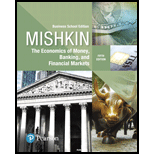
Three factors affecting the risk structure of interest rates
Concept Introduction:
The three factors affecting the risk structure of interest rates are:
- Default Risk
- Liquidity
- Income Tax Consideration
Explanation of Solution
Default Risk: This refers to the risk which may happen when an issuer of a bond is unable to pay back the face value and interest levied on it. The higher the default risk, higher would be the interest rate levied. The difference or the spread between the interest rate levied on default risk bond and default risk free bond is called risk premium. A bond with default risk will always have a positive risk premium and an increase in its default risk will raise its premium.
Liquidity: This is another factor that influences interest rates. A liquid asset is one that can easily be converted into cash. The higher the liquid an asset is, higher is the demand for such a bond, which would increase the price of a bond. With increase in price of bond, there will be decrease interest rate.
The result is that the difference or the spread between the interest rates of high liquid asset and the less liquid asset (called risk premium) is high. Higher the liquidity, less will be the interest rate.
Income Tax Consideration: A tax levied on income generated from bond determines interest rates. The higher the tax levied on income of bond, lower will be the demand.
For example, $2000-face value municipal Bond that sells for $2000 and pays only $160 in coupon payments, its interest rate is only 8%, but since it is tax-exempt, no tax is paid on $160 coupon payment.
While a corporate bond of $2000 face value has also the same attributes which a municipal bond has, but 40 %tax consideration, so coupon payment will be $160-$64=$96. So net income will be $96.
A person will be less interested in buying corporate bond than municipal bond. So, demand will increase of tax exempt bond, thereby increasing price. With increase in price, interest rate levied will be less.
Thus, higher income tax, lower will be the interest rate.
Thus, Default Risk, Liquidity and Income Tax consideration determines interest rates of bonds.
Want to see more full solutions like this?
Chapter 6 Solutions
Economics of Money, Banking and Financial Markets, The, Business School Edition (5th Edition) (What's New in Economics)

 Principles of Economics (12th Edition)EconomicsISBN:9780134078779Author:Karl E. Case, Ray C. Fair, Sharon E. OsterPublisher:PEARSON
Principles of Economics (12th Edition)EconomicsISBN:9780134078779Author:Karl E. Case, Ray C. Fair, Sharon E. OsterPublisher:PEARSON Engineering Economy (17th Edition)EconomicsISBN:9780134870069Author:William G. Sullivan, Elin M. Wicks, C. Patrick KoellingPublisher:PEARSON
Engineering Economy (17th Edition)EconomicsISBN:9780134870069Author:William G. Sullivan, Elin M. Wicks, C. Patrick KoellingPublisher:PEARSON Principles of Economics (MindTap Course List)EconomicsISBN:9781305585126Author:N. Gregory MankiwPublisher:Cengage Learning
Principles of Economics (MindTap Course List)EconomicsISBN:9781305585126Author:N. Gregory MankiwPublisher:Cengage Learning Managerial Economics: A Problem Solving ApproachEconomicsISBN:9781337106665Author:Luke M. Froeb, Brian T. McCann, Michael R. Ward, Mike ShorPublisher:Cengage Learning
Managerial Economics: A Problem Solving ApproachEconomicsISBN:9781337106665Author:Luke M. Froeb, Brian T. McCann, Michael R. Ward, Mike ShorPublisher:Cengage Learning Managerial Economics & Business Strategy (Mcgraw-...EconomicsISBN:9781259290619Author:Michael Baye, Jeff PrincePublisher:McGraw-Hill Education
Managerial Economics & Business Strategy (Mcgraw-...EconomicsISBN:9781259290619Author:Michael Baye, Jeff PrincePublisher:McGraw-Hill Education





